Start 14-Day Trial Subscription
*No credit card required

Everything You Need to Know About Hops (and Much More)
Here's an in-depth look at everything you need to know about hops, as well as how four popular hop varietals affect flavor, aroma and other characteristics.
With IPA as the leading craft beer style in America, even casual craft beer drinkers are aware that hops provide the bitter flavor in their favorite beers. But the way that hops are selected and their flavors and aromas are extracted is less well-known – more the territory of “mad chemist” brewers, who must draw on a knowledge of biology, chemistry and math to craft the next big thing. In fact, the ever-evolving chemistry between hops and beer is one of the most fascinating and intricate aspects of the craft beer universe. Here's an in-depth look at everything you need to know about hops as well as how four popular hop varietals affect the flavor, aroma and other characteristics of beer.
THE BASICS
Hops are the cone-shaped female flower of the vine-like plant humulus lupulus, and the important ingredients are concentrated in the cone’s lupulin glands. Hops are harvested from bines (aka tendrils), then dried and processed into pellets, plugs, extracts, or left in their cone form.
During the brewing process, hops are added at the beginning of the boiling stage to add bitterness to a beer's flavor and more are added at the end of the boil for aroma and flavor. Hops also act as a preservative by inhibiting spoilage bacteria during a beer’s shelf life and they help to stabilize foam.
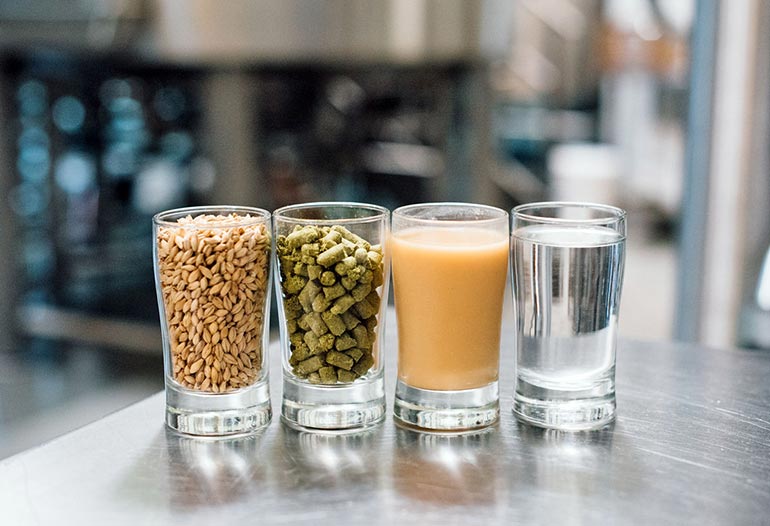
The four basic ingredients in brewing: malted barley, hops (in pellet form), a yeast slurry and water. Like scientists who experiment to learn how different substances interact, combine and change, modern brewers are known to get creative with any type of hop at any stage of the brewing process.
Photo Courtesy pFriem Family Brewers
Europeans probably began cultivating hop flowers for beer around the eighth or ninth century, and the hop heads of the 14th and 15th centuries are to thank for hop leaves overtaking other herbs and spices when it comes to flavoring beer. Today there are many dozens of varietals, sometimes labeled “old world” and “new world.” Ideal growing conditions exist between the 35th and 55th parallels in both hemispheres, so a few regions produce the majority of the world’s hops. The United States (“new world”) and Germany (“old world”) are the leading producers.
Bruce Wolf, owner of Willamette Valley Hops, said that the growing region can have a significant impact on hop characteristics. “Not just the dirt, but the climate and the weather pattern throughout the spring and summer dictates a lot of what the hop profile is,” he said. So the challenge, he noted, is ensuring consistency for craft brewers who depend on certain hop varietals for their beers.
THE CHEMISTRY OF EXTRACTION
Those early hop heads knew hops made beer awesome, but thanks to science, we have a better understanding of why.
There are two general categories of hops: bittering hops, which have a higher alpha acid content and contribute more bitterness but tend to impart a less refined flavor and aroma; and aroma hops, which are lower in alpha acids, but contribute desirable flavor and aroma characteristics. Some hops are dual-purpose.
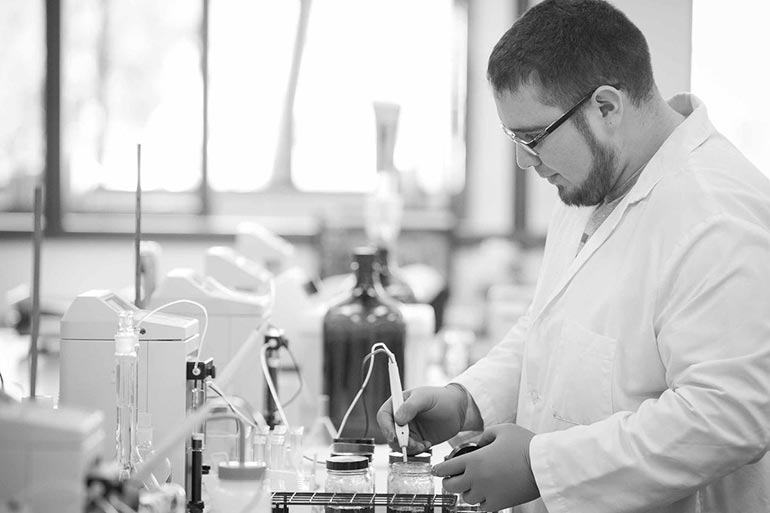
A sample is prepared for the analysis of bitter acids in hops at Haas, a hops supplier, hops breeder and research brewery.
Photo Courtesy Haas
Alpha acids such as humulone, adhumulone and cohumulone are very important to understanding how hops add bitterness. They are expressed in a weight percent generally ranging from 2 to 19 percent. Many European hops have alpha acids in the 5 to 9 percent range, which means these hops are used for aroma and flavor, or they may be dual-purpose. Newer American hop varietals are typically higher in alpha acids, around 8 to 19 percent, and contribute more bitterness.
Boiling extracts the desired characteristics. In the case of bittering hops with higher alpha acids, longer boils (usually 60 minutes or more) will cause the alpha acids to isomerize. That’s the process by which a molecule is transformed into another molecule with the same, but rearranged, atoms.
With this chemical switcheroo complete, the alpha acids are now iso-alpha acids, also known as isohumulones. These bad boys are responsible for the bitter flavor of beer. So beers with high IBU counts (international bitterness units) are those that have a higher concentration of iso-alpha acids. The most common way to measure IBUs is called spectrophotometry, which can also be used to measure a beer's SRM (Standard Reference Method for specifying color) and usually involves fairly expensive equipment.
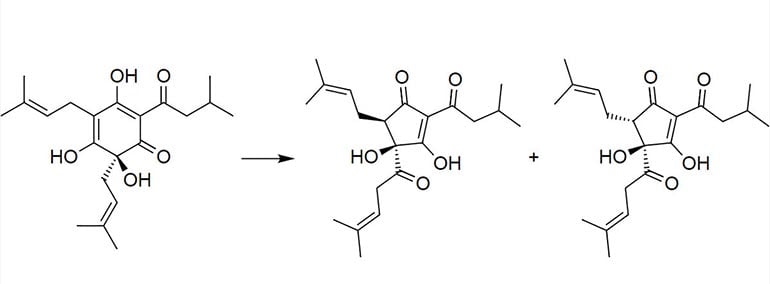
Humulone Isomerization
Hops also contain beta acids. Instead of isomerizing during the boil, they tend to oxidize, a process involving the loss of electrons that can result in an unpleasant flavor. Brewers generally prefer hops with a low beta acid content for this reason, though beta acids can contribute aroma if added at the right time.
In the case of aroma hops, the goal is to extract the volatile essential oils that are responsible for the aroma or flavor character of a beer. Not as much is understood about the chemistry of hop essential oils in comparison with hop acids because of their complexity and the changes that take place during brewing.
Because the oils are largely lost by steam evaporation during the boil, aroma hops are often added at the end for about 5-15 minutes. Dry hopping − the practice of soaking hops after the wort has cooled in the fermenter – helps extract these oils and is understood to contribute a more assertive and fresh hop aroma and flavor. Recent hop research has looked at whether dry hopping really makes a difference, and the results are mixed.

At Haas, a researcher prepares to analyze hop essential oils.
Photo Courtesy Haas
It’s worth noting that hop extracts – vs. pellets, plugs or whole cones – are treated a little differently in the brewing process. Isomerization can be achieved by adding other chemical compounds (such as alkalis or magnesium salts) or by exposure to a specific wavelength of light, instead of through boiling. Iso-alpha acid extracts are also available but are added later in the process, usually during secondary fermentation. Extracts have become more popular in recent years because they have a longer shelf life, do not require refrigeration, cut down on boiling time and there is no need to strain used hops afterward.
While extracts are a popular tool to increase flavor and aroma, they’re not necessarily a perfect replacement. Tim Kostelecky, a hops and brewing technical specialist with supply and research company Haas, said that hop solids (which are absent from extracts) contribute to the characteristics of “hop forward” styles.
“The hop solids contain many water soluble compounds that can contribute additional flavor and mouthfeel beyond what is expected typically from hop resins,” he said. These compounds react in unique ways to create specific hop characteristics, such as polyphenols, which he said are “a secondary source of hop bitterness and astringent ‘tannin’ mouthfeel.”
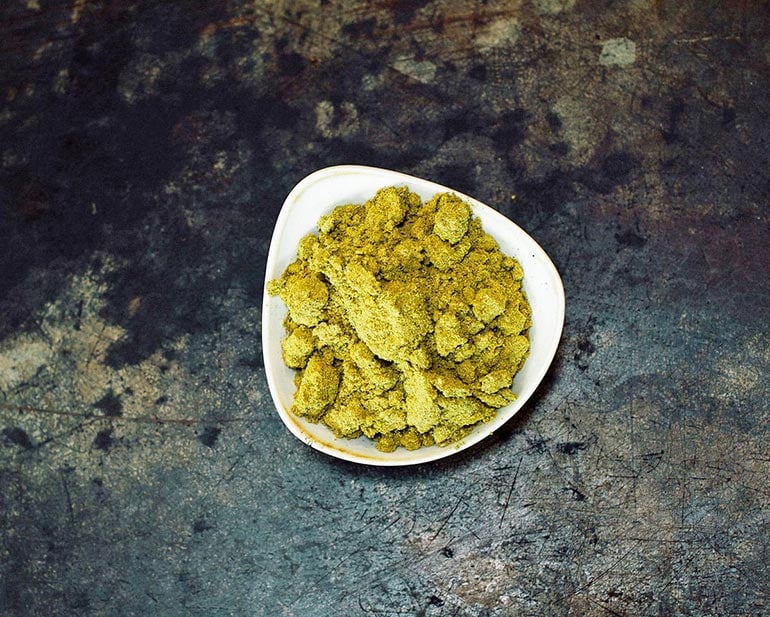
Cryo Hops are a relatively new development in hop processing. According to Yakima Chief – Hopunion, the proprietary cryogenic separation process produces a concentrated product, which is used in brewing to enhance hop flavor and aroma.
Photo Courtesy pFriem Family Brewers
DO THE MATH
To achieve desired characteristics, brewers must be familiar with several equations.
Extraction efficiency, or utilization rate: The efficiency of the isomerization of the alpha acids as a function of time. It is affected by factors such as boil time, boil vigor, wort gravity and pH, which means the equation may be different for each brew. So why bother? It’s important to know when brewers need to scale up or replicate a recipe.
Hop bitterness units (HBU), or hop bitterness coefficient: A formula developed by homebrewing pioneer Fred Eckhardt that helps calculate the bitterness of a homebrewed beer in lieu of the sophisticated equipment required to measure IBUs. The alpha acid percentage is multiplied by the number of ounces to be boiled, so 1.5 ounces of hops at 8 percent alpha acids = 12 HBUs. Brewers also can use the formula when they have to substitute one hop varietal for another in a particular recipe (not uncommon due to the challenges of supply and demand). For example, 3 ounces of hops at 5 percent alpha acids could be substituted for 2 ounces of hops at 7.5 percent alpha acids.
Sophisticated equipment helps ensure consistency in commercial brewing. For dedicated homebrewers, online calculators and software can help achieve desired hop characteristics, and data can be shared through BeerXML.
FOUR POPULAR HOP EXAMPLES
The primary factors brewers must consider when choosing hops are adherence to style and tradition, but they also take into account how the hops will complement other beer characteristics, such as the malt, esters and water mineral profile. While there are myriad different varieties of hops here’s a closer look at four popular hops and how they are used.
Cascade
The most popular hop in craft brewing today was developed by the USDA’s hop breeding program and released to brewers in the 1970s. Its name comes from the Cascade mountain range in Oregon and it is considered the first American-bred aroma hop. Cascade hops are known as the hops that launched a craft beer revolution when Anchor Steam used it to create Liberty Ale, the first IPA brewed after Prohibition. Sierra Nevada Pale Ale is another well-known example that employs the Cascade varietal. Alpha acids are in the 5 to 8 percent range, typical for an aroma/dual-purpose hop.
Cascade’s aroma is citrusy, often described as having a grapefruit-like character, and has distinct floral notes. Dr. Thomas Shellhammer, a professor of fermentation science at Oregon State University, said at a beer conference in Belgium that Cascade set the stage “for a whole wave of very fruity, citrusy, tropical flavored hops” that have arrived more recently and represent the future of hop breeding in the U.S.
Mosaic
This patented varietal, developed by a private company in the Yakima Valley, burst onto the craft beer scene in 2012. With high alpha acids, around 10.5 to 14 percent, its popularity stems from the complex “mosaic” of aromas it offers – tropical fruit, citrus, berry, pine, grass, spice and more. Its unique qualities are what make it so sought after, says Bruce Wolf of Willamette Valley Hops, noting that demand has exceeded the available supply. Mosaic can be found in just about any style today, though it is most often used in IPAs and Pale Ales.
This hop is so hot right now that many beers even feature “Mosaic” in the name, such as Breckenbridge Brewing Company’s Mango Mosaic and pFriem Family Brewers’ Mosaic Single Hop Pale. pFriem Family Brewers Brewmaster and Co-Founder Josh Pfriem said they began experimenting with Mosaic even before it was released to the market and have featured it as part of their “Single Hop Pale” series, which involves trying new or unfamiliar hops with the same base beer, a strong pale ale.
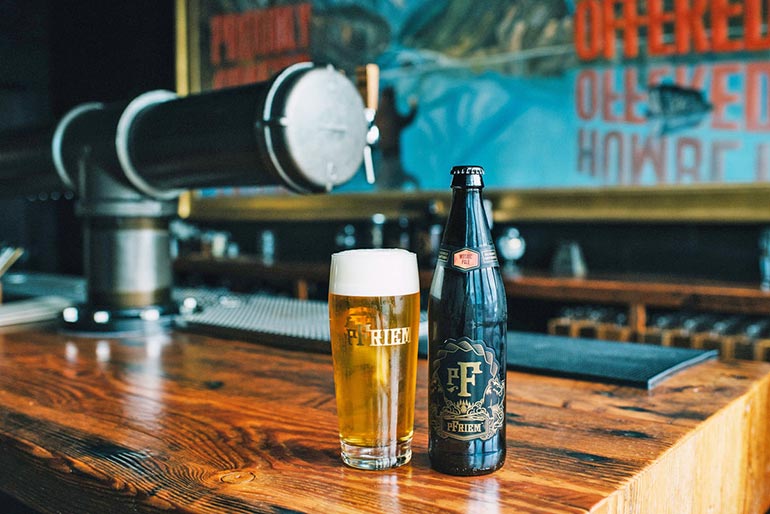
pFriem Family Brewers’ Mosaic Single Hop Pale is an example of a beer that showcases Mosaic, a newer varietal in high demand.
Photo Courtesy pFriem Family Brewers
“We have put many hops through this program and few have been able to create such full and complete flavors as Mosaic. This year’s beer really highlights the fresh melon and papaya attributes of the hop,” Pfriem said. He also noted that clearly marketing beers around specific varietals can help more knowledgeable consumers compare how different breweries use the same hop.
Galena
Galena’s name comes from the Roman word for the mineral galenite, which is found in Oregon’s soil. Another product of the USDA breeding program, it was one of the first “high alpha” hops that helped perpetuate the obsession with increasingly bitter brews. Galena, considered a “clean” bittering hop, has been popular among both commercial brewers and homebrewers because its high alpha acids (13 to 15 percent) impart a clean or mellow bitterness that can be complemented by finishing or aroma hops.
More recently, brewers have been turning to Galena for its aroma characteristics: sweet fruits, grapefruit, lime, blackcurrant and spicy wood. Galena can be found in styles ranging from Barleywines to Stouts to Brown Ales.
On the macro brewing side, Galena is used in Corona Extra. A dramatically different example of Galena hop usage comes from Tröegs Independent Brewing’s Nitro Chocolate Stout.
Hallertau
Hallertau is a region in Bavaria, Germany, rather than a single hop, and some varietals are grown in Washington and Oregon. They are one of four so-called “noble hops” used in early European beers that are still in use today. Hallertau, or Hallertauer, varietals are typically characterized as having a spicy, floral, earthy or herbal aroma. Alpha acids are usually around 3.5 to 6.5 percent, and while versatile, most Hallertaus are used as aroma hops.
Often associated with lagers, Hallertau hops can be found in a range of styles, from Pale Ales to Hefeweizen to Kölsch. One of the most famous examples is the Sam Adams Boston Lager, which is brewed with Hallertau Mittelfrüh and Tettang Tettnager hops. Hangar 24 Craft Brewing’s 24 Blonde Ale is a recent craft example; the Hallertauer hops were used to add just a touch of bitterness (it has only 14 IBUs). Beyond Hallertau, Tettnanger is another popular variety that is produced in Germany.
While the U.S. and Germany are known for their production of different hop varieties, Australia and New Zealand have also become popular hop production hubs in recent years.
THE FUTURE OF HOPS
Bruce Wolf of Willamette Valley Hops says the two main categories of hops are giving way to a third: hops sought after for their flavor. Mosaic, Citra, Galaxy and other fruity or tropical hops all fall into this category. These are the kinds of hops that brewers can use to craft unique brews that will help them stand out in a crowded field.
And while growers and suppliers grapple with developing new varietals and ensuring their availability, Tim Kostelecky at Haas says hop research is looking at how to reduce process loss in brewing IPAs and other styles where a significant volume of hops is required, as well as creating advanced products from carbon dioxide-extracted hop components that can help brewers amp up flavor (or fine tune specific flavors) more efficiently.
Most brewers – scientists at heart – will admit they enjoy experimenting with hops for the pure joy of it, that the thrill of the occasional success outweighs any failures. What will they cook up next? We can’t wait to find out.
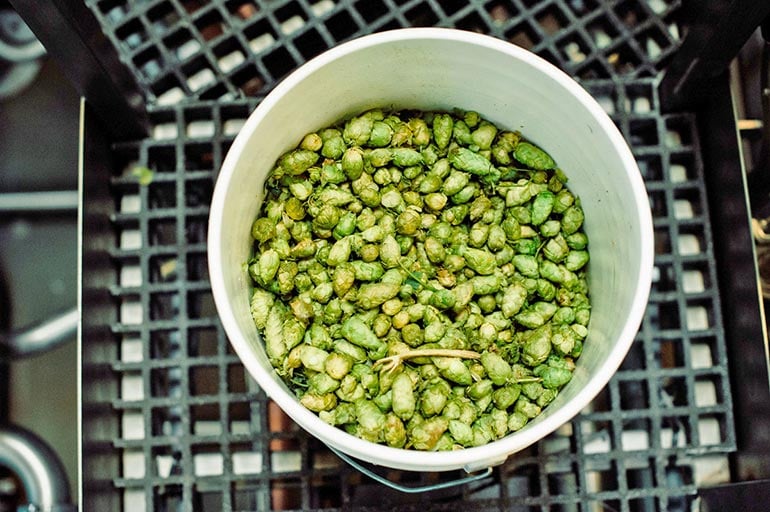
Photo Courtesy pFriem Family Brewers




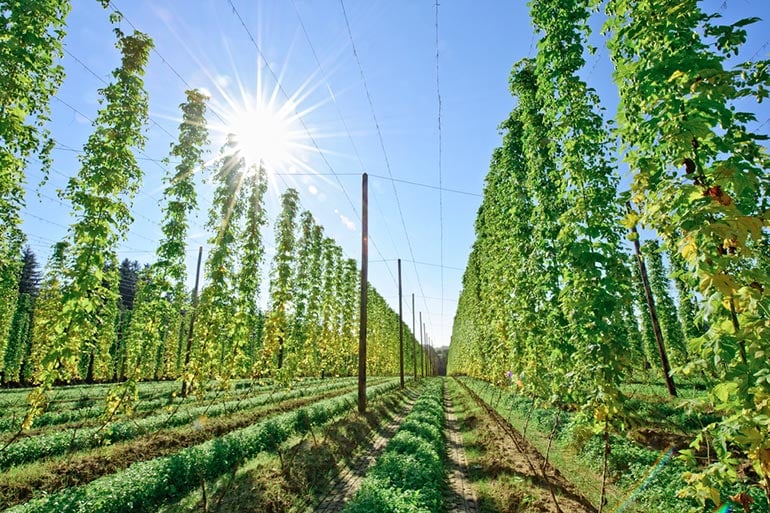
Comments